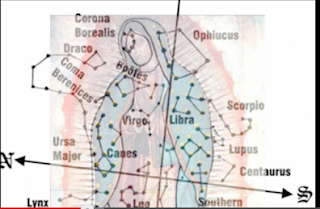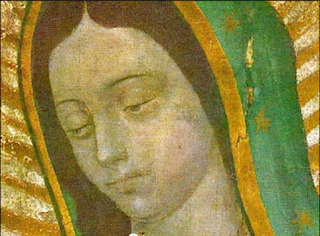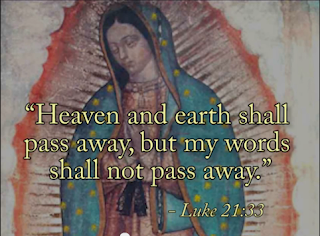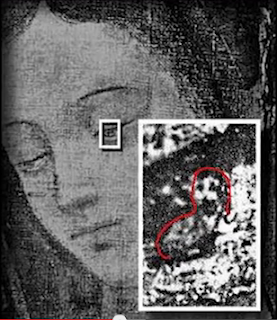The Miraculous Image of Guadalupe - by Bro. Peter Dimond (www.vaticancatholic.com)
_________________________________________________"I want to talk about the Miraculous Image of Our Lady of Guadalupe.
 |
| Juan Diego |
It first appeared on December 12th, 1531. According to the account, an Indian named Juan Diego had been visited by the Virgin numerous times.
She told him to go to the Bishop so that a chapel could be built, but the Bishop did not believe Juan.
The Bishop asked Juan to tell the Lady to give a sign as a proof that it was truly the Mother of God who had appeared.
 |
| Juan Diego visited by the Blessed Virgin Mary |
She told him to go to the Bishop so that a chapel could be built, but the Bishop did not believe Juan.
The Bishop asked Juan to tell the Lady to give a sign as a proof that it was truly the Mother of God who had appeared.
 |
| Roses and the miraculous image |
As he did so, the roses fell to the floor and the image of Guadalupe was miraculously imprinted on his tilma.
 |
| Our Lady gives proof to the Bishop |
It still exists to this day, 481 years later, and it can be visited in Mexico.
 |
| Image of Our Lady of Guadalupe in Mexico |
Image has no Undersketching or Underdrawing
The first miraculous aspect of the image that I want to discuss concerns the lack of an undersketch or an underdrawing.
Infrared photography has demonstrated that there is no undersketching or underdrawing on the image of Guadalupe.
That is miraculous, because as Dr. Philip Callahan, a research biophysicist from the University of Florida, explains, " It's inconceivable that an artist in the 16th century would paint a portrait without first doing a drawing on it."
 |
| Infrared photographs show no underdrawing |
Making an undersketch prior to painting a portrait goes back to antiquity. Thus, the fact that we have such an exquisite image with such precise details and features, and that it appears on a rough cactus fibre, is inexplicable, when you consider there is no undersketch."
Image has miraculously endured for almost 500 years
The next miraculous aspect of the image of Guadalupe that I want to discuss concerns its endurance.
 |
| Miraculous endurance of the face of the image |
The tilma is made of rough cactus fibre, as I said. This kind of cloth normally disintegrates in 15 - 30 years, but the image of Guadalupe has now remained for 481 years, with no fading or even hairline cracking of the face and the main image.
That is miraculous.
This is even more astonishing when we consider that the image was subject to candle smoke for many years, which would speed up the process of deterioration.
Attempts to reproduce image have all failed
Indeed, attempts to make imitations copies of the image have failed. "One famous example concerns a well known anti-apparitionist, named Jose de Ignacio Bartolache."
 |
| Imitation copy by Jose de Ignacio Bartolache |
In order to try to disprove the miraculous nature of the image, he had an exact copy made on the same burlap type material, and he hung it with great fanfare in the chapel built on the site of Our Lady's final appearance.
But, after 7 short years, the painting was so unsightly and discoloured that on June 8, 1796, it was quietly moved to the sacristy.
That's quoted in Brother Herbert Leie's , "Mother for a New World, Our Lady of Guadalupe." p.394.
That's quoted in Brother Herbert Leie's , "Mother for a New World, Our Lady of Guadalupe." p.394.
That means that attempts to reproduce the image have failed miserably.
Colors have miraculously remained fresh and bright
Concerning the miraculous endurance of the image, the following quote is of interest. I mentioned Dr. Philip Callahan earlier.
 He points out that "The mantle is a dark turquoise blue ... This presents an inexplicable phenomenon, because all such pigments are known to be subject to considerable fading with time, especially in hot climates. The Indian Mayan blue paintings are already badly faded. The blue mantle [ on the Tilma of Guadalupe ] however, is bright enough to have been laid last week."
He points out that "The mantle is a dark turquoise blue ... This presents an inexplicable phenomenon, because all such pigments are known to be subject to considerable fading with time, especially in hot climates. The Indian Mayan blue paintings are already badly faded. The blue mantle [ on the Tilma of Guadalupe ] however, is bright enough to have been laid last week."
So the colors are miraculously fresh and bright.
 There's also the amazing fact that in 1778, a considerable amount of nitric acid was spilt on the image of Guadalupe. The workman fled in terror, expecting to have seriously damaged his country's most treasured possession. But, to everyone's astonishment, only slight stains appeared, which can be seen in the upper right hand corner.
There's also the amazing fact that in 1778, a considerable amount of nitric acid was spilt on the image of Guadalupe. The workman fled in terror, expecting to have seriously damaged his country's most treasured possession. But, to everyone's astonishment, only slight stains appeared, which can be seen in the upper right hand corner.
That's quoted in Janet Barber, "The Tilma and it's Miraculous Image - A handbook on Guadalupe," p.61-62.
There's also the fact that in 1921, a bomb was concealed in some flowers that were placed on the altar under the image of Guadalupe.

The bomb went off and severely damaged a crucifix, but the glass that contains the image of Guadalupe, miraculously was not even damaged
Stars on the Image of Guadalupe
The next miraculous aspect of the image that I want to discuss, concerns the stars.
Some people have concluded that the stars, as well as the sunburst and the moon are add-ons, and that the original image was simpler.
 |
| Close-up showing sunburst and moon |
Dr.Philip Callahan is one who holds this idea. He still believes that the image is miraculous, but that the original image was simpler.
I believe he is incorrect on this point for two reasons.
Stars on the image represent constellations for December 12, 1531
First, it was discovered in 1983 by Dr. Juan Homero Hernandez, and Fr. Mario Rojas Sanchez, that that the stars on the image correspond precisely to the constellations of the winter sky on December 12th, 1531.
 |
| Juan Diego sees Our Lady |
And, what's so fascinating is that the constellations are shown as viewed from outside the heavens, in other words, in reverse. It's as if we have a picture from someone looking at it from outside the universe. It's a snapshot of Heaven and Earth from the very moment that Juan Diego saw Our Lady.
Flowers and Stars on Image
 |
| Flowers correspond to volcanoes in Mexico |
In other words, the interior portion of the miraculous image, which is multifaceted in its nature of instructing and awing, represents the Earth. The turquoise mantle on the outside, featuring the miraculous stars, representing the constellations, represents the heavens.
It's the picture of the encounter between Heaven and Earth, when Our Lady appeared to Juan Diego on December 12th, 1531, and captured miraculously and still present on the cactus fibre almost 500 years later.
But what's even more amazing, is that the stars appear only on the mantle of the image, and not on the tunic, and as I said, the stars that appear correspond to the constellations in the sky on the day of December 12th, 1531.
 |
| Constellations in the sky December 12, 1531 |
That signifies that Mary has a crown, and that she is the Queen of Heaven.
The constellation, Virgo, signifying virginal purity, would appear over the area of her heart, signifying her immaculate and virginal heart, and the constellation, Leo the Lion, would be over her womb.
 |
| Superimposed image of Our Lady on stars that day |
And there's even more.
All of this shows the Divine and indeed, Infinite Intelligence behind this miraculous production.
 |
| Divine and Infinite Intelligence behind miraculous image |
However, we know that this is not true because there is a copy of the image of our Lady of Guadalupe from 1570, which was used at Lepanto, and it corresponds precisely to the image that we have now.
That means that if the stars were added on, they must have been added on between 1531 and 1570, which is highly unlikely. In addition, there is a famous picture of the image from the Codex Seville. This dates to perhaps just a few years after Our Lady's appearance in 1531, and this picture shows the sunburst and corresponds greatly to the image that we have now.
 |
| Image of Our Lady of Guadalupe at the Battle of Lepanto |
All of this supports that the stars and the sunburst and the moon were part of the original image.
 |
| No evidence of fading on Virgin's features |
Some are puzzled by the fact that while the face doesn't even show a hairline crack or fade, the sunburst, the stars and the moon show some evidence of flaking. I have an opinion about this, and I believe it fits with what we learn in Sacred Scripture.
 Concerning the stars, and the sun, and the moon, we are told in Luke 21:33, that "Heaven and earth shall pass away, but my words shall not pass away."
Concerning the stars, and the sun, and the moon, we are told in Luke 21:33, that "Heaven and earth shall pass away, but my words shall not pass away."
Hence, it makes sense that we would see evidence of the stars in the image, and the moon, and the sunburst fading, because in reality the heavens shall pass away, but the Virgin herself and the primary image surrounding her and her face are incorruptible, because she will shine forever in Heaven.
That would be why we see evidence of fading in the stars etc., but not in the Virgin's features.
Miraculous images in the eyes of the Virgin
The next miraculous feature I want to discuss, which might be the most miraculous feature of all, concerns the eyes of the image.
There's a fact that the image of a bearded man has been discovered in the eyes of the Virgin.
It was first discovered 1929 and again in 1951, and it was subsequently confirmed by modern science and intense investigation, the image of the bearded man with a full head of hair corresponds to pictures of Juan Diego, the Indian who saw Our Lady.
In other words, the image of Juan Diego, is microscopically captured in the Virgin's eye.
Of course, no human painter could have ever conceived the need to put microscopic images of Juan Diego in the eyes of the Virgin, so that they would later be discovered by the advances in modern science, and it is simply impossible for any human painter to have pulled it off, because the images are simply too small to paint.
And, the presence of the images in the eyes is even more amazing, because the images correspond exactly to what happens in the human eye when it sees something.
Jody Brant Smith, who studied the image of Guadalupe along with Dr. Callahan, is a non-Catholic. He explains. "Before I could understand the importance of his discovery, I needed to learn something about the physiology of the human eye, and particularly what is called the "Purkinje-Sanson Principle.
In its simplest form the Purkinje-Sanson Law states that whenever we see any object, the object is reflected in each eye, not once, but in three different places.
This threefold reflection is caused by the curvature of the eye's cornea.
Two of the reflections are always right-side up, and one is always upside down. That's quoted in Thomas Sennett's book, "Not made by hands," p.58. The reflections of Juan Diego in the Virgin's eye corresponds precisely to the Purkinje-Sanson Law.
Multiple reflections are found exactly as they would be found in a human eye that sees a person.
In fact, the Purkinje-Sanson Law shows that when a human being sees something, because of the differing angles of the curvature of the cornea, the various reflected images are apparently distorted in a varying degree, and in the images within the eye of the Virgin of Guadalupe, "There's is a perfect collocation and agreement with this principle."
The distortion of the figures even concurring with the predicted curvature of the cornea. that is, to say, the images appear exactly as we would expect them to appear in a human eye. That means that what we have here in the image of Guadalupe, still fresh today, on the rough cactus fibre, is the visual reproduction of that Heavenly encounter in 1531.
And, this is true on many levels. Not only does the image miraculously capture what Juan Diego saw, it captures his vision of the Virgin and the meeting of Heaven and Earth, with the stars as they appeared in the heavens on that day, but also in the microscopic recesses of the Virgin's eye, this unspeakably amazing image captures exactly what the Virgin saw, just as it would have been captured in your eye, if you saw another person in your room.
And there's even more.
"In 1981, Jose Tonsmann, a systems engineer, electrified lovers of Mary of Guadalupe, by announcing that his computerized blow-ups of photos of her eyes had revealed microscopically small figures which he suggests could be Bishop elect Zumarraga, Juan Diego, the interpreter, Juan Gonzalez, a black woman, an Indian family, a small child and a man."
In other words, this computer engineer, when he blew-up the image of the eye many times, discovered the presence of essentially a whole room full of individuals captured within the eye of the Virgin.
Dr. Escalante, a surgical ophthalmologist, considers these reflections to belong to the type which have been described by Schurning, on the back surface of the cornea, and by Volt and Hess at the centre of the lens. Such reflections are very difficult to detect.
Dr. Escalante has also reported the discovery of small veins on both of the eyelids of the image.
In the 1970's, a Japanese optician, who was examining the eyes, fainted.
When he recovered, he said that, "the eyes were alive and looking at him." Janet Barber, "Latest Scientific Findings on the Images in the eye - A Handbook on Guadalupe," p.90
In other words, the image of Juan Diego, is microscopically captured in the Virgin's eye.
Of course, no human painter could have ever conceived the need to put microscopic images of Juan Diego in the eyes of the Virgin, so that they would later be discovered by the advances in modern science, and it is simply impossible for any human painter to have pulled it off, because the images are simply too small to paint.
And, the presence of the images in the eyes is even more amazing, because the images correspond exactly to what happens in the human eye when it sees something.
 |
| Purkinje-Sanson Law |
In its simplest form the Purkinje-Sanson Law states that whenever we see any object, the object is reflected in each eye, not once, but in three different places.
This threefold reflection is caused by the curvature of the eye's cornea.
Two of the reflections are always right-side up, and one is always upside down. That's quoted in Thomas Sennett's book, "Not made by hands," p.58. The reflections of Juan Diego in the Virgin's eye corresponds precisely to the Purkinje-Sanson Law.
Multiple reflections are found exactly as they would be found in a human eye that sees a person.
In fact, the Purkinje-Sanson Law shows that when a human being sees something, because of the differing angles of the curvature of the cornea, the various reflected images are apparently distorted in a varying degree, and in the images within the eye of the Virgin of Guadalupe, "There's is a perfect collocation and agreement with this principle."
 |
| Meeting between Heaven and Earth |
And, this is true on many levels. Not only does the image miraculously capture what Juan Diego saw, it captures his vision of the Virgin and the meeting of Heaven and Earth, with the stars as they appeared in the heavens on that day, but also in the microscopic recesses of the Virgin's eye, this unspeakably amazing image captures exactly what the Virgin saw, just as it would have been captured in your eye, if you saw another person in your room.
And there's even more.
"In 1981, Jose Tonsmann, a systems engineer, electrified lovers of Mary of Guadalupe, by announcing that his computerized blow-ups of photos of her eyes had revealed microscopically small figures which he suggests could be Bishop elect Zumarraga, Juan Diego, the interpreter, Juan Gonzalez, a black woman, an Indian family, a small child and a man."
 |
| Microscopic images in Virgin's eye |
Dr. Escalante, a surgical ophthalmologist, considers these reflections to belong to the type which have been described by Schurning, on the back surface of the cornea, and by Volt and Hess at the centre of the lens. Such reflections are very difficult to detect.
Dr. Escalante has also reported the discovery of small veins on both of the eyelids of the image.
In the 1970's, a Japanese optician, who was examining the eyes, fainted.
When he recovered, he said that, "the eyes were alive and looking at him." Janet Barber, "Latest Scientific Findings on the Images in the eye - A Handbook on Guadalupe," p.90
So, this Japanese optician fainted because he thought that the eyes were human and looking at him.
We have numerous people captured microscopically in the recesses of the image of the eye. This is undeniable proof the image is miraculous. Only God could have done this.
Moreover, "Opthalmologists have testified that even though they are opaque, both eyes in the image show depth and become filled with light when the ophthalmoscope light is trained into them.
They have asserted that it would be impossible to produce with paints such perfectly placed reflections in eyes offering so little space with the Virgin looking down, and on such rough material as the tilma."
That's from the same source quoted.
The scientific findings about the eyes of the image leave no doubt that the image is of Divine origin and was created by God to leave the world with a priceless gift, a picture of that encounter, the Mother of God and Juan Diego.
The Miraculous Changing Face Color of Our Lady
The next miraculous aspect that I want to discuss, concerns the face of Our Lady.
 |
| Our Lady appears as a native American |
This miraculous feature is meant to show the unity of the two people who were then coming together as one in the true faith of Christ, and the new nation that had just uprooted the diabolical Aztec culture.
 |
| The diabolical Aztec Culture |
In fact, Dr. Philip Callahan explains that the image achieves this effect of appearing to be different colors at different distances, only by a miraculous feature that we see in nature. He says, "At a distance of 6 or 7 feet, the skin tone becomes, what might be best termed indian olive/grey-green in tone.
 |
| Our Lady appears of European descent |
It appears somehow the grey and caked-looking white pigment of the face and hands, combines with the rough surface of the unsized hue.
Such a technique would be an impossible accomplishment in human hands. It often occurs in nature, however, in the coloring of bird feathers and butterfly scales, and on the elytra of brightly colored beetles.
So, what he is saying, is that the miraculous feature of a change of color at different distances, is something we see in nature on beetles and on bird feathers and on butterfly scales, and that it occurs on the tilma in a miraculous way.
 |
| Natures miracle reproduced on Our Lady's image |
The pigment combine with the rough surface of the cloth to give it a different effect, yet it is still beautiful and delicate at every distance.
This is simply a miracle, and no human artist could have ever accomplished this effect. It was fashioned by God, just as the butterfly scales are.
Temperature of the Image of Guadalupe
The next miraculous feature that I want to mention concerns the temperature.
 |
| Image remains at an even 36.5 deg C |
Rebellions and Conversions
 |
| Martin Luther's rebellion spawns countless sects |
It's also worth mentioning that Martin Luther, by his rebellion against the Catholic Church, and his creation of a new kind of false Christianity, spawned countless sects which tore 5 million from the Catholic Church, was born in 1483.
 |
| Countless Protestant sects |
The most significant events in Luther's life was occurring at about the exact time that Hernen Cortez was accomplishing the overthrow of the Aztec Empire.
 |
| Hernen Cortez |
It's almost as if, at the very moment that millions in Europe were been torn from the true Church, God was arranging it so that twice as many in the New World were being brought into it.
 |
| The Aztec Empire |
Perhaps God gave it to Mexico, because the Aztec Empire was arguably the most wicked culture in human history. He wanted to counteract that level of evil with something even of greater good.
 |
| Overthrowing of the Aztec Empire |
Let those who seek the truth, and those who love the truth and those who love the Christ, embrace this message, and the one true faith of Jesus Christ, the Catholic faith.
 |
| The one true faith of Jesus Christ - the Catholic faith |
Image was a Hieroglyphic Letter to the Indians
Another miraculous aspect of the image of Guadalupe concerns the reading of the Image. "The Indians saw something in the image of Our Lady that the Spaniards did not comprehend.
In that period, the Indians did their writing in hieroglyphics, so to them the image was a hieroglyphic letter.
 |
| Huitzilopochtli - Aztec sun god |
The crescent or the moon beneath her feet show their moon god, Tezcatlipoca, was less than nothing, since she was standing on it.
 |
| Tezcatlipoca - Aztec moon god |
The stars they thought so much of, were only a part or a portion of her mantle.
 |
| Cross - emblem of the Spanish Friars |
At her throat was a brooch with a small black cross in the centre, reminding them that this was the emblem of the Spanish Friars, and that there was one greater than she. That comes from Father Harold Rahm, "Am I not Here." P.56
 |
| Brooch with a small black cross |
As we can see the intelligence that constructed the miraculous image of Guadalupe, which conveyed exactly the message that the Indians needed to hear and see, to bury their false notions about God, and their idolatrous practices, is infinite and beyond anything humans can imagine.
 |
| Miraculous image of Guadalupe causes millions to put away their idols |
Reading the image caused millions to put away their idols and convert to the Catholic faith."
 |
| Miraculous image of Our Lady |





No comments:
Post a Comment